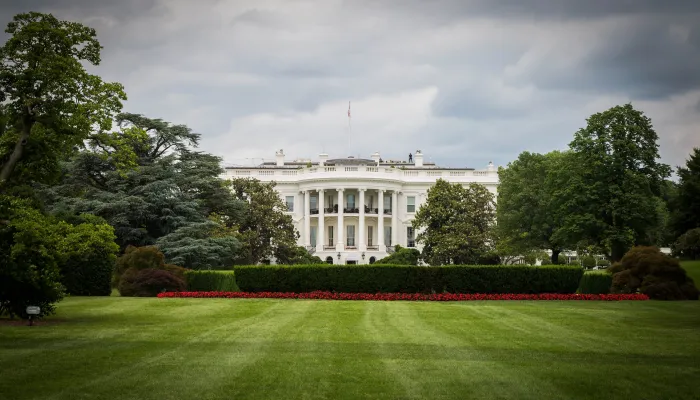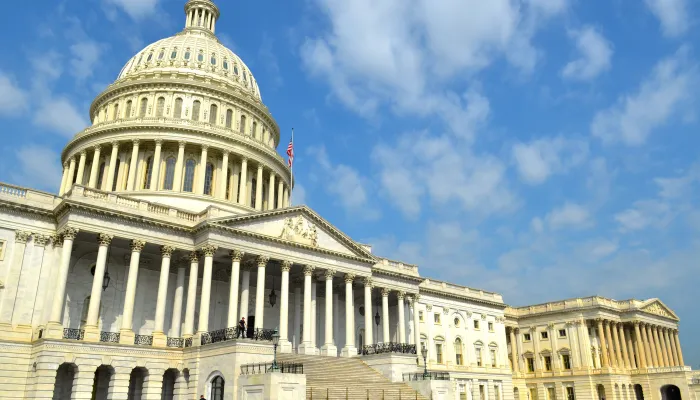The Better Budget Process Initiative: Setting the Benchmark: Reforms to Budget Baseline Rules
Budget baselines are among the most important – but widely misunderstood – elements of budgeting and policymaking. The budgetary impact of a given legislative change can be measured in several ways. Baselines allow us to measure the future effect of changes relative to projections under the status quo.
Budget baselines are produced by the Congressional Budget Office (CBO), Office of Management and Budget (OMB), and a number of outside organizations (including the Committee for a Responsible Federal Budget). In general, they serve two purposes – to provide projections of current fiscal policy and to offer a measuring stick to compare policy changes. As CBO explains, “CBO’s baseline is not intended to provide a forecast of future outcomes; rather, it is meant to provide a neutral benchmark against which the budgetary effects of proposed changes in federal revenues or spending are measured.”1
CBO describes its baseline as a “current law” baseline, meaning it projects spending and revenue assuming no legislative changes. In reality, it is a current law baseline modified with CBO’s default assumptions. For example, the baseline assumes discretionary appropriations are passed each year (and grow with inflation), various expiring mandatory programs continue, trust fund depletion does not constrain spending on programs paid from those funds, and the debt limit continues to be raised over time.
These departures from current law intend to allow CBO’s baseline to better serve as a neutral benchmark. However, within the current baseline framework there are opportunities for gimmicks and other fiscal mischief as well as unnecessary confusion. As part of our Better Budget Process Initiative, we have identified six potential changes to baseline rules that would better serve policymakers and the public:
- Treat temporary provisions consistently
- Assume enforcement of trust fund limitations in the baseline
- Compare discretionary appropriations to the prior year’s levels
- Provide information on sources of growth in mandatory spending
- Remove emergency spending from the baseline
- Separate the budget enforcement baseline and budget projections
1. Treat Temporary Provisions Consistently
Current practice: Under current baseline rules, there is inconsistent treatment of expiring tax breaks and spending programs. Generally, CBO must assume that mandatory spending programs and tax provisions expire as set out in current law. However, budget rules allow the Budget Committees and OMB to determine, in consultation with CBO, if new spending programs costing over $50 million annually will continue after their expiration for measurement purposes. This rule applies only to stand-alone legislation that creates or extends a program; it does not apply to individual provisions that supplement an existing program like extended unemployment benefits, a temporary increase in Supplemental Nutrition Assistance Program (SNAP, or food stamps) benefits, or temporary tax breaks.
The treatment of tax and spending programs affects a piece of legislation’s score and the baseline. If scorekeepers choose to assume a program continues after its expiration, current and future costs beyond expiration are recognized in the cost of the initial legislation, and reauthorizations of that legislation only score costs that differ from what the initial legislation would have provided.
Problem: The difference between temporary spending and tax provisions creates confusion and invites controversy. In addition, the current treatment of temporary tax provisions incentivizes policymakers to enact temporary tax breaks at a lower official cost and then later argue to ignore the costs of extending the breaks because policymakers are simply maintaining current policy. (For example, the deduction for state and local sales taxes enacted in 2004 was a temporary provision to limit the cost of the provision within a revenue-neutral tax bill, but it was repeatedly extended and made permanent in the tax extenders agreement in 2015 without offsets.) The incentive to enact tax breaks on a temporary basis creates uncertainty in the tax code in addition to creating openings for fiscal irresponsibility.
Proposal: Baseline rules should score every new tax or spending bill as permanent and should include the permanent cost of these bills in the baseline. The same rule should apply to any new extensions of existing policies. If policymakers want new provisions to be permanently incorporated into the baseline, these same provisions should be scored with an upfront understanding of the full costs and be subject to budget enforcement tools like PAYGO requirements.2
Legislation that explicitly states that the new provision is temporary and Congress does not intend to extend it (for example, short-term economic stimulus) should be exempt. Under this exception, the costs of such a provision after expiration would be excluded from the baseline, and if lawmakers later decide to extend the temporary provision, they must acknowledge the cost of the extension and offset it.
This rule would ensure more consistency when scoring new legislation while also preventing Congress from artificially limiting costs by making a spending program or tax provision temporary with the intention of extending it later.
Are current baseline rules for temporary provisions biased against tax provisions?
Some critics of current baseline rules argue that because policymakers will likely extend temporary tax breaks, a baseline assuming the tax provisions will expire (as provided in current law) is unrealistic and misleading. However, baselines do not intend to reflect what is likely to happen. Rather, baselines help determine the impact legislation will have on current law. The fact that policymakers could extend an expiring provision does not guarantee the law will pass nor does it guarantee the content of the law. Further, if baselines assume legislation extending an expiring provision will pass, then the full costs of that provision are unaccounted for.
A more sophisticated argument suggests that current baseline rules treat revenue and spending differently and create a pro-spending bias in budget rules. There is a kernel of truth to this; some types of spending – like farm payments and Temporary Assistance for Needy Families (TANF) – do expire but are permanent in the baseline. Unlike temporary tax provisions, CBO does not score a “cost” to extending them. However, there is also a major difference. The original ten-year score of the legislation creating or extending the program generally assumes their costs beyond their expiration.
| Program | Scoring of Initial Legislation | Baseline Treatment | When Are Costs Beyond Expiration Scored? |
|---|---|---|---|
| TANF | Permanent | Permanent | When Enacted |
| Unemployment Insurance Extensions | Temporary | Temporary | When Extended |
| Bonus Depreciation | Temporary | Temporary | When Extended |
| Tax Extenders Under Proposal | Temporary | Permanent | Neither |
For example, a new “four-year” spending program scores as though it will last for ten years when it is first considered, so adherence to PAYGO requires Congress to offset the costs over ten years as if it were permanent. Extending the program for the remaining six years does not need offsets, since Congress has already offset the program’s ten-year costs. Policymakers essentially “pay for baseline” by offsetting the costs of a new program as if it is permanent in exchange for the costs being included in the baseline.
By contrast, temporary tax breaks and spending provisions, as well as programs treated as temporary by scorekeepers, score with a smaller cost initially. Legislation that later extends the provision would be scored with additional costs beyond the expiration date that was established in the initial legislation.
In short, the treatment of tax and spending provisions in the baseline is consistent with how the legislation was originally scored.
It would be fiscally irresponsible and dishonest to score a temporary provision with lower, temporary costs, and later incorporate a higher cost into the baseline as if the provisions were permanent. This would effectively let policymakers enact costly tax breaks while only acknowledging a small portion of their cost and then extend them without charging for the additional cost.
As then-CBO Director Peter Orszag explained:
A fundamental principle for the integrity of the budget process is that, when a particular policy or program has a set expiration date, its long-term cost should be scored either at the time of enactment or when it is extended beyond the expiration date. … Scoring expiring provisions as entailing no budgetary cost after their expiration, but then assuming their extension in the baseline, would cause the costs of extending those provisions to “disappear” from the process—which would substantially undermine its integrity.3
Changing baseline rules to assume temporary tax breaks continue in the baseline after they expire, as some have advocated, undermines the integrity of the budget process by failing to account for the true cost of laws while opening a huge loophole in budget enforcement.
2. Assume Enforcement of Trust Fund Limitations in the Baseline
Current practice: The baseline generally assumes that programs continue as specified under current law; however, the issue of what constitutes current law is not straightforward for programs funded through trust funds. Many programs with dedicated funding streams and trust funds prohibit spending in excess of revenues and trust fund assets. At the same time, several of these programs make commitments for future spending in excess of projected future revenues. Examples include the Social Security, Medicare Hospital Insurance, and Highway Trust Funds.
Current baseline rules assume spending in trust fund programs continue at whatever level is necessary to meet commitments under current law, even after the trust funds deplete and revenues are insufficient to meet spending commitments. This shortfall between spending and revenue is part of the projected baseline deficit.
Problem: The current treatment of trust fund spending creates tension between the program’s obligation in current law to pay full benefits or provide funding and the limitation in law to not spend more than it has. Moreover, it creates opportunities for double counting and increases “unpaid-for” spending. Using legislation that increases a trust fund’s solvency to pay for other deficit-increasing policies effectively double counts the assets: first to extend the trust fund’s life, and second to pay for other legislation.
Further, a policy that increases trust fund solvency also increases spending relative to a strict interpretation of current law by ensuring that future outlays will not reduce due to insolvency. However, since the baseline assumes spending will continue even after trust fund depletion, legislation that achieves savings extending trust fund solvency does not score the costs of the increased spending made possible by extending trust fund solvency. Thus, the savings in the legislation that increases the trust fund’s solvency can both increase spending from the trust fund and offset other deficit-increasing policies. In addition, this assumption allows Congress to make transfers to the trust fund from “general revenue” to fulfill spending commitments after the trust fund depletes without accounting for the costs of spending made possible by the transfer.
Proposal: The baseline should assume spending from trust funds is limited to dedicated revenues. This would prevent legislation that extends trust fund solvency from scoring with savings that can offset other costs. In addition, general revenue transfers to trust funds would score as increasing spending.
3. Compare discretionary appropriations to the prior year’s levels
Current practice: Current baseline rules assume discretionary programs increase each year with projected inflation (Employment Cost Index for personnel and GDP price index for all other spending).
Problem: While the current inflated baseline provides useful information about how much spending needs to increase to maintain the same level of services and purchasing power for a program or activity, comparing discretionary appropriations to inflation-adjusted levels obscures actual increases in discretionary spending and arguably creates a bias toward higher spending.
Proposal: The President’s budget, committee reports for the budget resolution, and appropriations bills as well as any CBO reports and estimates for appropriations bills should be required to compare proposed funding levels to the prior year’s level in addition to the current inflated baseline. If the baseline is a neutral benchmark for evaluating legislation, the actual amount appropriated for a program or activity in the prior year is a more apt measure for comparison. Policymakers should also have access to comparisons with inflation-adjusted levels and the amount necessary to cover increased costs due to population growth as well, but showing a comparison to the prior year’s level would ensure that the actual nominal increase (or decrease) in spending is prominently displayed for all programs and activities. The projections for total discretionary spending in the baseline in future years should continue to reflect inflation-adjusted levels or discretionary spending limits to provide a realistic picture of future spending.
4. Provide information on sources of growth in mandatory spending
Current practice: The baselines published by OMB and CBO show growth in mandatory spending under current law. Unlike discretionary spending, mandatory spending increases automatically to meet current law obligations without Congressional action. Therefore, the baseline assumes spending grows as necessary to comply with current law, and Congress only pays for the costs of legislation that expand mandatory spending programs above current law.
Problem: Baseline projections do not tell policymakers why mandatory spending is increasing. As a result, policymakers do not have a full understanding of what is driving mandatory spending growth, what will be necessary to reduce the growth, and the consequences of holding spending growth below baseline projections.
Proposal: The President’s budget and CBO’s budget outlook should be required to present information about sources of mandatory spending growth under current law. The sources could include inflation, built-in per person benefit or cost growth, rising beneficiaries or caseloads, increased utilization of services, and other factors. This would give policymakers a better understanding of which factors are contributing to spending growth. It would also allow them to make better-informed decisions about the appropriate level of mandatory spending and determine what will be necessary to hold spending growth to desired levels.
5. Remove emergency spending from the baseline
Current Practice: Under current baseline rules, CBO and OMB assume the prior year’s total discretionary spending will increase with inflation, including spending with emergency designations and overseas contingency operations (OCO) spending.
Problem: Emergency spending is conceptually “supposed” to be a one-time outlay; including it in the baseline artificially inflates the baseline, particularly in years with large amounts of emergency spending. OCO spending has declined or remained flat for the last several years, so policymakers are able to claim savings relative to the baseline by limiting OCO spending to the lower levels necessary for the upcoming year.
Fig. 1: Overseas Contingency Operations Outlays (in billions)

Source: CBO, OMB, CRFB Calculations
Proposal: Baseline projections should not assume emergency or OCO spending continues. This would prevent Congress from claiming artificial savings. Because spending for emergencies and OCO are both exempt from budget discipline, eliminating that spending from the baseline and scoring the costs of new emergency spending or OCO spending should not cause any problems.
6. Separate the budget enforcement baseline from budget projections
Current Practice: CBO produces a single baseline that both shows fiscal projections moving forward and serves as a neutral benchmark relative to current law.
Problem: In trying to serve as both a realistic set of fiscal projections and a neutral benchmark, CBO’s baseline does neither as well as it could. A move toward a more pure current law baseline might in many ways serve as a better neutral benchmark, but it would almost certainly serve a less realistic projection of things to come. Note that some of the proposals we’ve made above would help make the CBO baseline a more neutral benchmark, while others would help to make it a more realistic set of projections; few would do both.
Proposal: Direct CBO to publish two baselines: a budget enforcement baseline and budget projections baseline.
The budget enforcement baseline would serve as a tool to measure the fiscal impact of legislation for purposes of enforcing budget rules. It would assume all provisions expire as designated under current law and trust fund limitations are enforced. It would not include emergency or OCO spending and would assume discretionary spending complies with statutory spending limits.
The budget projections baseline would provide policymakers with a more realistic projection of likely spending, revenue, and deficit levels. It would assume all provisions not designated as temporary continue. It would assume spending necessary to meet commitments in law continues after trust funds are depleted as well as discretionary spending that grows with inflation and reasonable other placeholder assumptions regarding emergency and OCO spending.
Conclusion
While baseline rules may seem arcane and technical, they have a major impact on the evaluation of legislation considered by Congress and application of budget rules. The reforms of baseline rules set out in this paper could provide policymakers with better information about the budget outlook and impact of legislation and eliminate gimmicks and loopholes that policymakers can exploit.
1 Congressional Budget Office, Updated Budget Projections 2016-2026, March 2016
2 PAYGO rules in the Senate and Statutory PAYGO require the costs of legislation scored as reducing revenues or increasing mandatory spending relative to the baseline to be offset with corresponding increases in revenues or reductions in mandatory spending over five- and ten-year budget windows.
3 Peter Orszag, Issues in Reinstating Statutory PAYGO Requirement, Testimony before House Budget Committee, July 25, 2007
What's Next
-
Image

-
Image

-
Image
